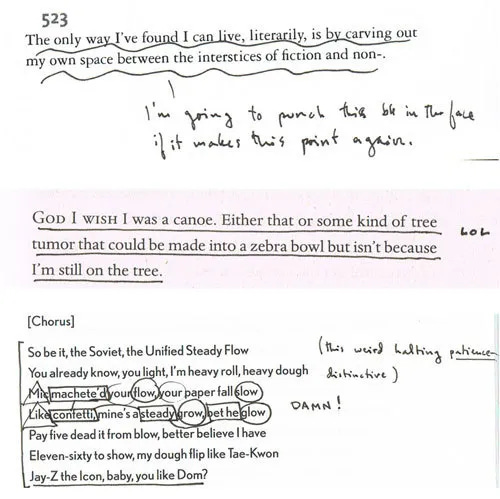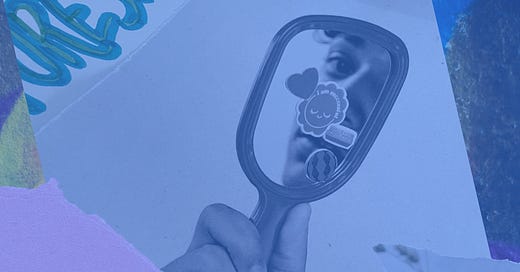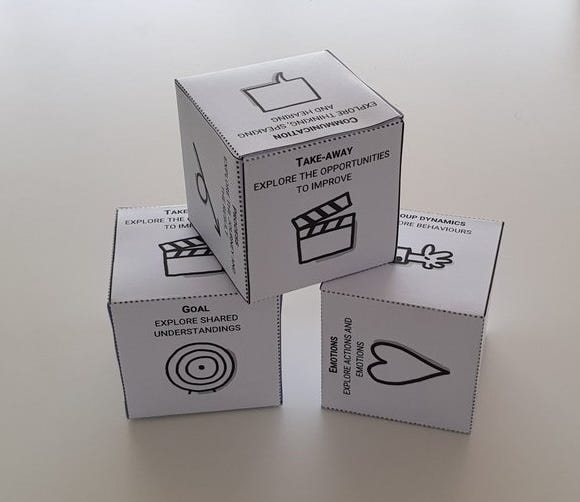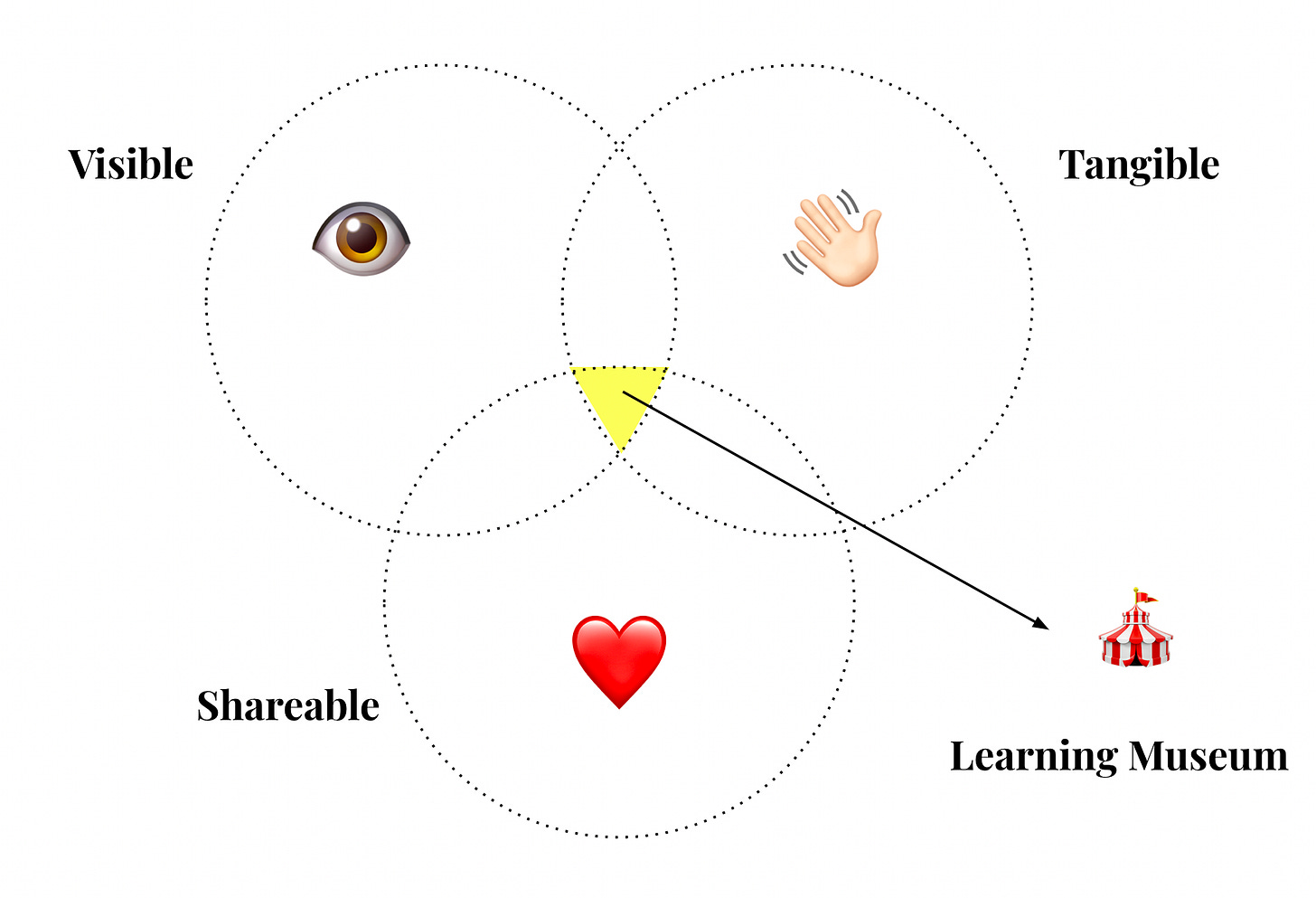We've been fed a lie. Practice doesn’t make perfect.
Why you should double-down on reflection when you design learning experiences.
I’m 37, and until recently, I thought I knew how I learned best: by doing.
It wasn’t until this year that I became so painfully aware that I was sabotaging my learning progress's potential because I rarely spent time reflecting.
Action is exciting and usually collaborative (in my case); decisions are made, stuff gets done, and you see the results, which is so satisfying. When you practice over and over again, you SEE yourself getting better. It’s motivating.
Reflection? Mmm…Not so much. Or so I thought.
Working with a fantastic accountability buddy, having a few brilliant coaching sessions, and starting a morning journaling habit showed me that reflective moments can lead to profound personal and professional insights. More than once, I thought: “Wow, this is so cool! Where are these ideas coming from?”.
It felt like I possessed an unknown “wisdom” I wasn’t aware of.
Was I missing out all this time I wasn’t paying attention to reflection?
At work, we place lots of emphasis on the experience someone has. Doing the work, repeating the tasks, failing, succeeding—accumulating experience through repetition, practice, and feedback tends to be associated with performance improvements.
In other words, you gotta put in the reps. 💪
And that’s also how we design learning. We know how important spaced repetition is, as well as practice, feedback, and effortful retrieval of prior knowledge we have acquired.
Where does reflection fit in all of this?
What is it, and how does it impact learning and performance?
Let’s explore. 💡
We’ve been told a lie. Practice doesn’t make perfect.
TL;DR:
—Once a certain amount of experience has been accumulated through practice (doing), the benefit of accumulating additional experience is inferior to the benefit of coupling the previously accumulated experience with some efforts at articulating and codifying it.
—15 minutes of reflection at the end of the training day, led to a 20% boost in performance compared to the acquiring more knoweldge and practising.
—When working with an easy task: talking it out is sufficient.
—When challenged with the task: writing it out, mapping and drawing is more efficient.
—If you are a novice to the task: elaborating on the task, talking and writing about it is enough.
—If you are an expert: thinking in terms of strategy, linking it to other concepts, sense-making, and exploring the implications is more impactful.
—The act of stoping and thinking about the experience is valuable, no matter if what we are reflecting on is a good or a bad performance.
Well, damn!
This isn’t just one study. There’s also this one. And this one. And the list goes on.
It’s fascinating.
It turns out that practice AND reflection make perfect.
“Experiential and reflective learning are deeply intertwined: Reflection can take place only if an individual has accumulated sufficient experience on which to reflect. That said, as soon as this condition is satisfied, experiential and reflective learning become mutually exclusive choices: Every additional minute spent reflecting is a minute of lost practice, and one more minute spent practicing means one less minute available for reflection.
In light of this trade-off, we ask: What is the best way to allocate our learning time?”
(Di Stefano, Gino, Pisano, Staats—2014)
Why reflection deserves more time in the spotlight
According to research, in its most potent form, reflection entails:
Having an experience (doing) +
Articulating the experience (thinking, sharing, discussing) +
Codifying the results of this articulation (writing, linking, abstracting)
= Reflection
In other words, reflection involves stopping and taking the time to articulate and codify our experiences.
Why care for it?
Why care for it as novices—
For starters, reflection is key in self-directed learning. To intentionally learn anything from scratch, we use reflection to check our progress, make sense of our learning, and pivot our strategy when needed.
Learning something new requires a good dose of intrinsic motivation and a strong belief that we have the ability to succeed in specific situations or accomplish a task (called self-efficacy by Bandura in 1997).
It turns out that intentionally elaborating on our experience and practice when we learn something new (by talking or writing), helps us understand cause-effect mechanisms from practice (Kale and Singh, 2007) and enriches our mental models (Ellis and Davidi 2005, and Goh et al. 2013).
As we begin to understand the task, we discover new strategies to accomplish it more effectively. We see the improvements, and our self-efficacy gets a boost, which in turn motivates us to continue our learning journey. The pace of progress is rewarding.
Why care for it as experts—
As we master the fundamentals, repetition and consistency help us become more efficient and make fewer errors. This is what it feels like to “be able to do the thing.” It’s comfortable, and our confidence is high.
Repetition and consistency also create habits, and habits are steered by the automatic and routine centers of the brain.
As we get better at something, we descend into automatic pilot. This is what Kahneman (2011 calls “system 1 thinking”, which does not require working memory and is typically described as fast, non-conscious, intuitive, automatic, associative, and independent of cognitive ability. It is associated with implicit learning.
The automatic pilot diverts our attention from the task we already know. And what doesn’t capture our brain’s attention does not exist. As a result, our progression pace slows down and becomes less rewarding. Our motivation might sink.
This is where most of us reach the so-called “learning plateau”, where we seem to stop making visible progress.
That in itself is not bad unless we want to continue honing that skill to a level of mastery—to go from being good to exceptional. Outstanding.
Here is where reflection comes into play. It is a doorway into awareness. A way for the expert to shut down the autopilot and continue to intentionally and strategically pull the practice apart, find new, unexpected connections, tune into small insights, and draw fresh lessons that may not be apparent through action, practice, and repetition.
Kahneman (2011) calls this “system 2 thinking,” which is defined as a reflective process that requires working memory. It is typically described as slow, conscious, controlled, and correlated with cognitive ability. It is also associated with explicit learning.
Reflection is like a magnifying glass over all the little details you’ve missed with the naked eye.
Why care for it as people living our lives—
I know two types of people:
One that will tell you they haven't learned anything new, when what they want to say is that they haven’t attended a formal training lately. 🫣
And those who will tell you that we learn all the time. 😎
I’m one of the rebels who think we learn all the time.
But do we REALLY learn all the time?
No two experiences are the same. If every experience is unique, it can lead to new insights and learning.
Yet, unless something big, new, or unexpected happens, these insights are often overlooked because we rarely take the time to spot, surface, inspect, make sense of, and see how they fit into our mental models.
I only became aware of this through my daily journaling and gratitude practice.
Reflection is a doorway into awareness.
It’s like a magnifying glass over all the little details you’ve missed with the naked eye.
What does that mean for us learning designers in practice?
I can’t resist a good “So what?” question. What are we supposed to do with all of this?
I researched and reflected (yoooo!😎✌️), and I want to leave you with a few ideas on how to embed reflection into different learning contexts.
To make this more fun and interesting, I curated three ideas for each context:
💁♀️ The “obvious go-to”
💡 The “interesting, tell me more”
😎 The “get outta here!”
Embedding reflection in collective sync learning sessions
💁♀️ The “obvious go-to”—Closing reflection
Close the session with a thought-provoking question that invites reflection. Ideally, you will invite participants to gather their thoughts and note their main takeaways in silence. Then, create small groups in which they can share their takeaways. The collective sharing will add new insights as participants see the experience through other people’s lenses.
Two of my favourite closing reflections are What? So What? Now What? and “I used to think…, and now I think…”
A fantastic resource for educators and learning designers is Project Zero’s Thinking Routines Toolbox.
💡 The “interesting, tell me more”—The Debriefing Cube
This is an effective way to “democratise” reflection. While you can use it to choose a set of questions to ask participants, I love giving them the freedom to autonomously manage the debriefing as a group. Give each small group a deck of cards and spread them out face down. Invite them to take turns selecting a card and starting the conversation by asking the question at the top. Bring everyone back together to share what they have discovered.
😎 The “get outta here!”—The Mirror Maze Experience
Ok, I cheated. I 100% used ChatGPT to design this one and am happy with the result.
The experience guides participants through a maze, each room offering a different space for thoughtful reflection. As they move through the maze, participants engage deeply with key concepts and share insights in a final collaborative space, creating a shared understanding of the topic.
Embedding reflection in async learning journeys
💁♀️ The “obvious go-to”—Riff, the reflection companion
Riff is a free AI-powered bot that asks questions to help you make sense of an experience. Embed Riff into your learning program from the start, and then layer it with small group conversations about the insights that surfaced from their interaction with Riff.
Voilá! You have two layers of articulation:
—asynchronous, by typing with Riff
—synchronous, by sharing with the group
💡 The “interesting, tell me more”—Learning Museum
Personal Learning Museums are a concept developed by Srishti Sehgal that makes learning visible, tangible, and shareable.
It can be used as a tool to capture:
Progress: Where a learner is in their learning journey
Achievement: How much the learner has accomplished
Effort: How much effort the learner has put
Competency: What knowledge, skills & mindsets a learner has
Srishti hosted a learning session for L&D Shakers two years ago and she deep-dived into this practice. You can catch up with the recording here.
For super easy implementation, design a Miro/ MURAL board and invite participants to capture their learning as the program unfolds. They can drop insights, images, links, and resources on the whiteboard. Use it each time they reflect, and link it to specific sharing activities to bring it to life.
😎 The “get outta here!”—Collective annotations
I LOVED this idea from
“Studies have shown that when learners annotate texts together, they engage more critically and comprehensively with the material. This process encourages them to explain their thoughts, question each other's interpretations, and build on ideas, which can lead to deeper comprehension and memory retention.”—writes Stefy.

Books and printed documents are the original medium for marginalia, but Stefy found two online tools you can use for the same effect, but with digital books and PDFs. Explore the social annotation platforms called Perusall and Hypothesis.
THANK YOU, Stefy, for the inspiration; this was my favorite dispatch so far!
Embedding reflection in teamwork
💁♀️ The “obvious go-to”—Retrospectives
Schippers and co-authors (2013) point out that team performance benefits from conscious reflection about how the team functions, especially when teams begin with relatively low performance levels.
Retrospectives are meetings or discussions held after an event, project, or period has concluded to reflect on what happened, why it occurred, and how processes can be improved for the future. They are used widely in any context and process where continuous improvement is needed. Find lots of fun templates here and here.
If you are reflecting on co-creative and collaborative sessions, have a look at the CoReflect Toolkit by CCSDI. The cards address different topics, such as participants' experience of group dynamics, participation, and time management. By using the toolkit or a selection of the cards, you can improve future co-creative work.
💡 The “interesting, tell me more”—The Perspective Pause
This team ritual allows any team member to call out a "perspective pause" at any time during a meeting, workshop, or group discussion as an invitation to stop, zoom out, and examine the situation from ‘above’. The goal is for the group to reflect and discuss matters related to the team dynamics and ways of working, like how they communicate, make decisions, or interact in the moment.
This is inspired by Mischief Makers and their fantastic facilitation meta moments.
😎 The “get outta here!”—Fly on the wall
Anseel, Lievens, and Schollaert (2009) research found that reflection combined with feedback improved task performance more than when employees received only a feedback report. So, how might we encourage more reflection + feedback combos within our teams?
“Fly on the wall” is a team ritual in which a team member intentionally observes another team member's performance in a specific real-life situation and shares feedback based on those observations.
As a team member, I can proactively ask someone to be the “fly on the wall” for a project presentation I have to deliver and give me feedback afterward. Or, I can proactively decide to be the “fly on the wall” for another colleague in a team meeting and then offer to share my observations with them.
For a boost in impact, anyone receiving feedback based on observation needs to reflect on what they heard and share back their main takeaway.
Further resources for you to explore 🔎
For those of you with more time on your hands, Sejaal Tilwani wrote an excellent piece for L&D Shakers. In it, she explored David Kolb’s Experiential Learning Cycle and provided lots more ideas on how to embed reflection in learning experience design.
Fridays (and weekends) are great days to reflect on the week that’s passing, and so I remembered this PDF I shared a while back with 40+ reflection prompts I learned after asking LinkedIn what everyone’s favourite reflection prompts were.
I grouped them into five main categories: Learning, Growth, Action, Wellbeing, and Purpose, but you'll also find an "Others" page with questions that are so good they should be a category in themselves.
Do you have a reflection prompt you love?
Drop it in the comments, and help me grow this resource. 🌱
This newsletter is how I share what I am learning and discovering with the world, with no paywall involved. If you’ve found something useful here and would like to say “thanks”, buy me a coffee and I’ll feel most appreciated.
Have a fun weekend, and until next time—stay curious out there!
Anamaria







I’m happily reading this edition from a hammock with a cup of coffee, and WOW—great stuff here! I love how you made ‘Reflections’ the core of this edition—so much needed in a time of information overload. Recently, I decided to read less and better organize my notes, and I loved expanding the concept further with the references and observations shared here. Thank you!
Beautiful writing, Ana 🌿 I love this type of exploration of a topic like reflection 💡